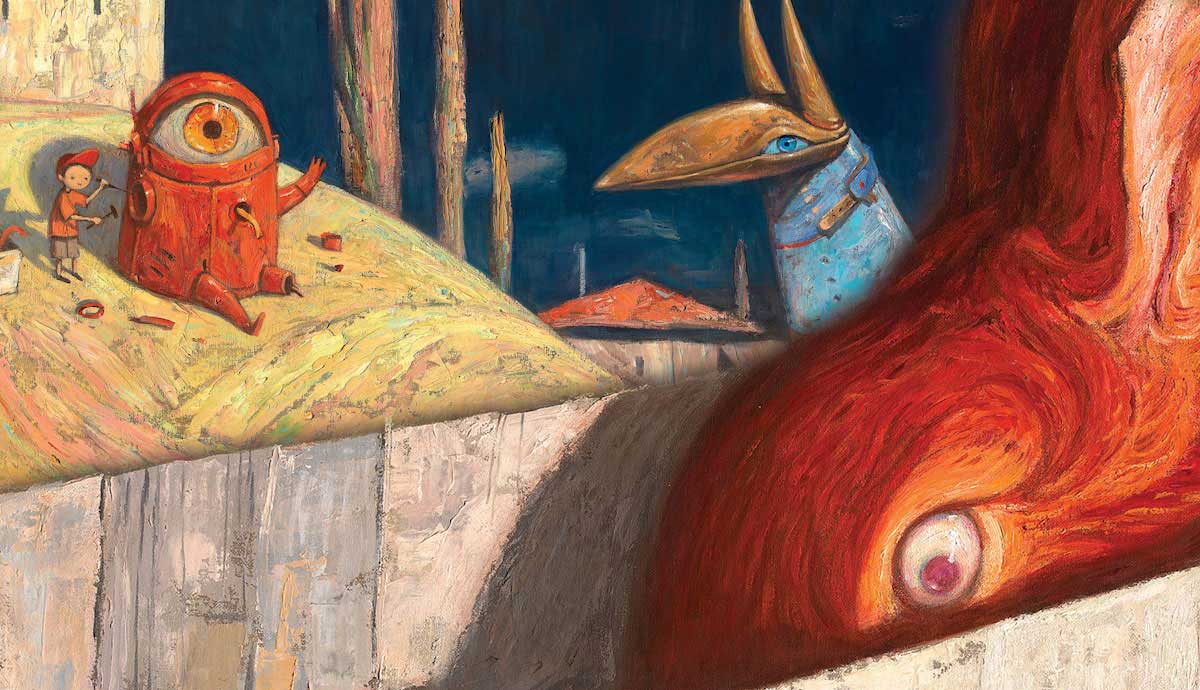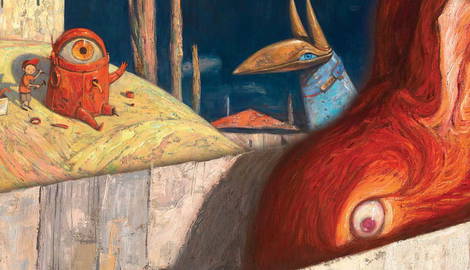
Shaun Tan was born in Australia in 1973. He is a painter, illustrator, writer, and filmmaker, best known for his picture books for which he has received numerous awards. Tan embraces the picture book as a genre not just for children but ideal for older readers as well. For him, the illustrations are the main texts of the stories. His books play with how text and image can run parallel and interact with each other across a gap. The characteristic strangeness of Tan’s worlds and characters is communicated, by and large, through his images.
The Style of Shaun Tan

Embracing ambiguity, Shaun Tan playfully raises questions about belonging, communication, and otherness. Moving across various mediums, hinting at surrealism, sci-fi, and steampunk traditions, among other influences, the worlds he depicts are richly rendered, dream-like, and uncanny cities or suburbs. It’s within these landscapes that we encounter the creature characters at the heart of Tan’s stories. Strange, hybrid, anthropomorphic, and endearing, take a look at 5 of them that appear in Tan’s illustrated books.
1. The Rabbits by Shaun Tan & John Marsden (1998)

The Rabbits is a postcolonial fable written by John Marsden. Narrated from the perspective of an animal native to a land that’s being colonized, it draws on the catastrophic impact of the introduction of rabbits as a foreign species into the Australian ecosystem. Marsden’s text is accompanied by opulent and unforgettable illustrations created by Tan. The key figures within these are his interpretation of the eponymous Rabbits, creatures in which he manipulates this familiar animal into an evocative embodiment of colonialism and its utilitarian brutality.
Tan’s illustrations narrate a transformation of the landscape from natural to industrial, from healthy and diverse to polluted and monocultural. These are mostly page-filling, richly textured paintings with mixed-media embellishments. Graphite comes up late in the book, emphasizing the depletion and bleakness of a newly industrialized world. Compositionally, the landscape here is paramount, with the figures often small-scale in comparison. Over the course of the book, this landscape transforms, under the relentless influence of the Rabbits, into a dark echo chamber of their own hard-edged, mechanical appearance.

The cover image shows the early part of the story, the arrival of the Rabbits on the land they will soon take over and destroy. The image refers to the 1902 painting The Landing of Captain Cook at Botany Bay 1770 by Australian impressionist artist E. Phillips Fox. Tan’s ship, mimicking the shape of the Rabbits themselves, looms over the land, an ominous anticipation of how the industry will overwhelm it. All angles, even those of Rabbits’ feet and shadows, are exaggerated into sharp, weapon-like points aimed piercingly toward this new territory.
2. The Lost Thing (2000)

The Lost Thing is a story about finding an unidentifiable and seemingly lost creature on the beach and, compassionately, trying to figure out where it belongs. As Tan states on his website, while the written text on its own could easily refer to a dog or other quotidian creature, it’s in his images that he explores the strangeness and implacability of this creature.
The world of The Lost Thing is situated in a slightly dystopian industrial city, both bleak and busy, laced together with pipes and mechanisms, its open spaces scattered with bits and bobs of rubbish. Echoing this and the subject matter of lost-and-found-things, a technique of collage bridges between text and image. The light throughout the images is predominantly that of a Summer evening, blending a sense of ending with lingering. The influence of Edward Hopper’s lonely, low-lit city scenes as well as Jeffrey Smart and John Brack has been noted by commenters like Gary Crew.

The thing itself is bright red and large. It looks like a hybrid of machinery and tentacle, industry and organism, with hints of teapot, boiler, and crustacean. Like many of Tan’s strangest and most enduring characters, it doesn’t speak for itself in the written text of the book. Disorientatingly, it also lacks a discernible face. As viewers, we don’t know where to focus.
In his essay Thing Theory, Bill Brown suggests we begin to confront the thingness of objects when they stop working for us: when the drill breaks, when the car stalls, when the window gets filthy… The story of objects asserting themselves as things, then, is the story of a changed relationship to the human subject. Tan’s visual narration of a lost thing, seemingly useless, unwanted, and suddenly and irreversibly noticed, evokes something of this thingness that Brown describes. It’s interesting to note that Tan won an Academy Award for a 2011 short film based on The Lost Thing.
3. The Arrival (2006)

The Arrival is the story of one man’s migration from his home country to a strange new metropolis. It follows his discoveries and the difficulties involved in this transition. It is a story told entirely in images, without accompanying text.
An abundance of detailed and atmospheric black and white (or digitally sepia tinted) graphite drawings make up The Arrival, sometimes taking the viewer through scenes like a cartoon strip, and at other times leaning into more expressionist or symbolic use of imagery. These images are dense with the disorientation of strange environments and the strange beings that occupy them.
However, unlike many of Tan’s books, the main character is, simply, a man: undeniably, mundanely human. Even a little nostalgically archaic, with his dark suit and rectangular suitcase. This story, Tan has acknowledged, is partly influenced by his own father’s experience migrating from Malaysia to Australia as a young man.

The strange creature from The Arrival is faceless, nameless, and more of an embodied metaphor for an unspecified sprawling and menacing threat than an individual character. All we see of this creature, which we might as well call The Old Country because that’s both where it appears in the narrative and how Tan has captioned a drawing in which it is clearly depicted on his website, are shadowy tentacle-like shapes rising from between buildings.

In his follow-up publication Sketches from a Nameless Land: The Art of The Arrival, Tan suggests that this creature, or mass of creatures, was present in his earliest ideas for the book: Some of my earliest concept sketches involved a young family walking through the decaying streets, beneath ambiguous black serpents. This was partly inspired by descriptions of troubled countries – one immigrant referring to the oppressive regime of his home as a fearful dragon. He also cites Francisco Goya as an influence for this work, along with photographs of industrial towns.
4. Tales of Outer Suburbia (2008)

Originally published as one tale among many in Tan’s 2008 Tales from Outer Suburbia, Eric was later released as a stand-alone picture book in 2010. This gives some indication of how compelling it is within its slightness and visual restraint.
Eric is a story about the brief visit of an exchange student, narrated from the perspective of the typical suburban family that he stays with. While the text describes a familiar social exchange of one human culture meeting another, the images introduce and follow Eric, a tiny, anthropomorphic, shadow-like creature who sleeps in a teacup, as he navigates a typical Western domestic environment.

Tan tells this story through a series of small graphite sketches and Eric’s design is a feat of moderation. Tan captures the feelings of otherness, curiosity, confusion, concern, and vulnerability that can be part of the meeting of two cultures. The black and white of the sketches, nodding, among other things to the mundanity of the familiar cultural landscape, is effectively ruptured with the arrival of color in the final image of the book.
5. Rules of Summer by Shaun Tan (2013)

Rules of Summer unfolds through a sequence of fairly self-contained images and scenes. The central characters are two boys, possibly brothers. The written text of the book is a list of rules which serve as captions for the images.
The relationship between what we read and what we see in the images is as delightfully enigmatic as anywhere in Tan’s work. Are the strange scenes, involving such strange creatures, supposed to be the consequences for breaking rules? The structure is reminiscent of the inexplicable ritual laws of childhood. Tan said that each picture might be seen as a chapter of an unwritten tale that can only be elaborated in the reader’s imagination.

The opening image of the book is hard to forget. The two boys crouch behind a wall, hiding from an enormous red bunny that appears to be hunting them. The caption reads Never leave a red sock on the clothesline, and perhaps only when you read this rule do you notice a tiny red sock in the foreground, coordinating with the rabbit monster.
According to Tan, this is one of the first images conceived for the book. Originally he had drawn a huge black dog, changing this later to the stranger and more comically ludicrous rabbit which felt more unsettling to him. It’s worth noting that there is a great diversity in the creatures and animals across Tan’s work. There are many waiting to be discovered.











